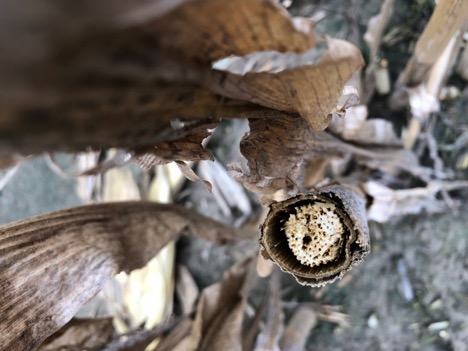The last two weeks have shown an increase in samples for stalk rots and ear rots/moldy grain at the Purdue Plant and Pest Diagnostic Laboratory, which is signaling that fields are in the middle of or nearing the end of harvest. Dr. Darcy Telenko has provided two great resources (Stalk Rots Getting You Down? & Ear and Stalk Rots) to help in identifying stalk rot diseases and how to manage them. Determining the type of pathogen is paramount in determining your management options, such as selecting hybrids with resistance to a particular pathogen, determining if/what pesticides will protect your crop, and what cultural practices will help mitigate the damage done (if only for future years).
Multiple corn leaf spot or root rot pathogens also infect the stalk and/or ear. Other ear rots can move in due to insect feeding, exposed ear tips subject to the environment, or rain getting underneath the husk. Knowing what you have earlier in the year, both from leaf spots and seedling rots/blights, can help you figure out potential risks for stalk and ear rots later in the season.
| Different Tissue Types Corn Pathogens Can Infect | ||||
| Corn Pathogen | Root | Leaf | Stalk | Ear/Cob |
| Aspergillus | X (seedling) | X | ||
| Anthracnose | X | X | ||
| Diplodia | X (seedling) | X | X | X |
| Fusarium | X | X | X | X |
| Gibberella | X | X | ||
| Nigrospora | X (seedling) | X | ||
| Bipolaris (NCLS) | X (seedling) | X | X | |
| Penicillium | X (seedling) | X | ||
| Physoderma | X | X | ||
Anthracnose
Too Far Gone: Various Stalk Rot Pathogens Isolated
Since August 1st, 2019, we have received 100 corn samples and were submitted primarily for leaf spot and cultural issues (See Dr. Bob Nielsen’s article on Premature Plant Death Due to Drought Stress). The following sample summary only includes the samples from August 1st, so it is not indicative of the entire growing season.
| Purdue PPDL Corn Sample Summary (Aug. 1 – Oct. 6) | |
| Corn Disease | Number Times Diagnosed |
| Abiotic (Cultural, Environmental, Insects, Physiological) | 18 |
| Anthracnose Leaf Blight | 4 |
| Anthracnose Stalk Rot | 2 |
| Common Corn Rust | 25 |
| Common Corn Smut | 1 |
| Gray Leaf Spot | 34 |
| Gibberella Stalk Rot | 2 |
| Diplodia Leaf Streak | 4 |
| Diplodia Stalk Rot | 2 |
| Fusarium Stalk Rot | 3 |
| Northern Corn Leaf Blight | 16 |
| Northern Corn Leaf Blight | 10 |
| Physoderma Brown Spot | 6 |
| Southern Corn Rust | 34 |
| Charcoal Rot (Stalk) | 2 |
| Tar Spot of Corn | 19 |
Please note that this summary only represents the samples our lab has received and it includes all diagnoses. Samples we receive often have multiple issues at once, so the number of diagnoses will be higher than the number of samples received.







